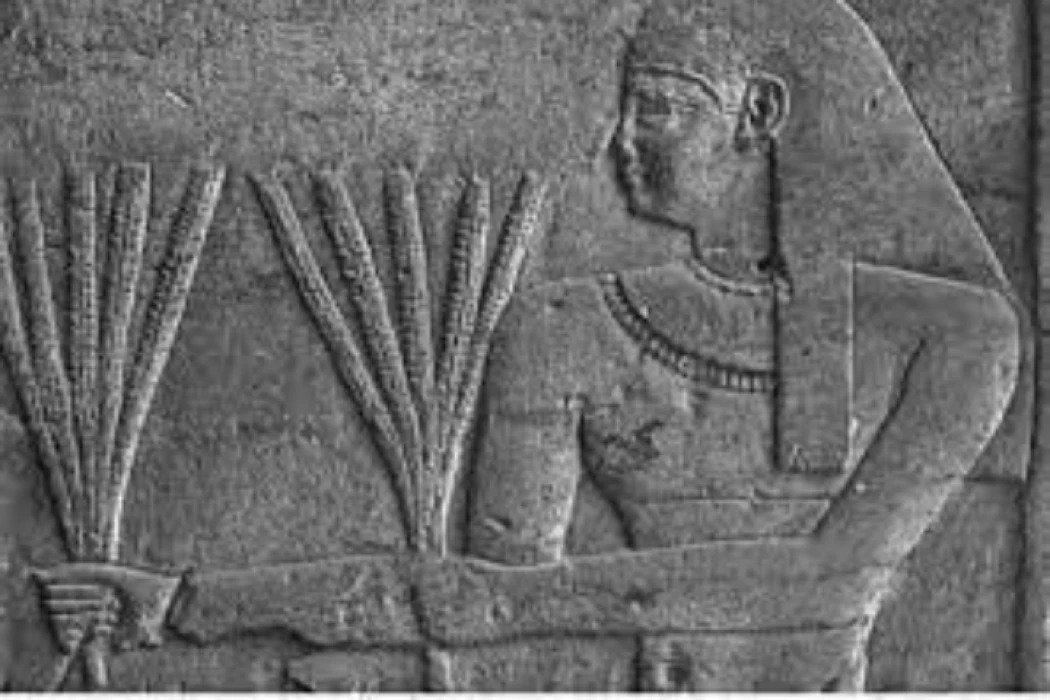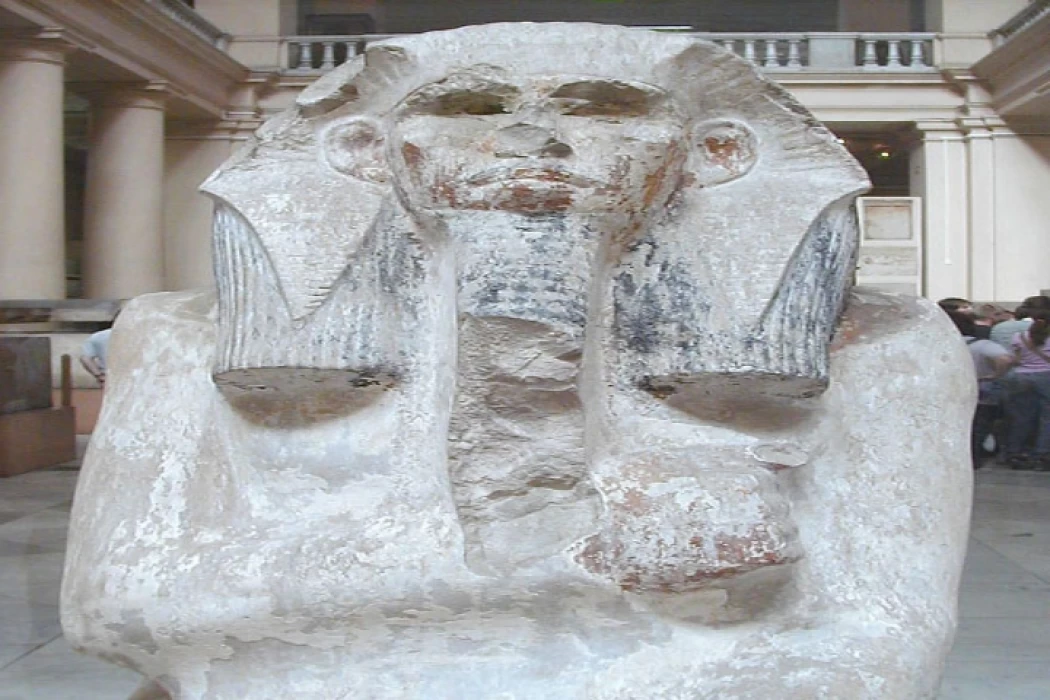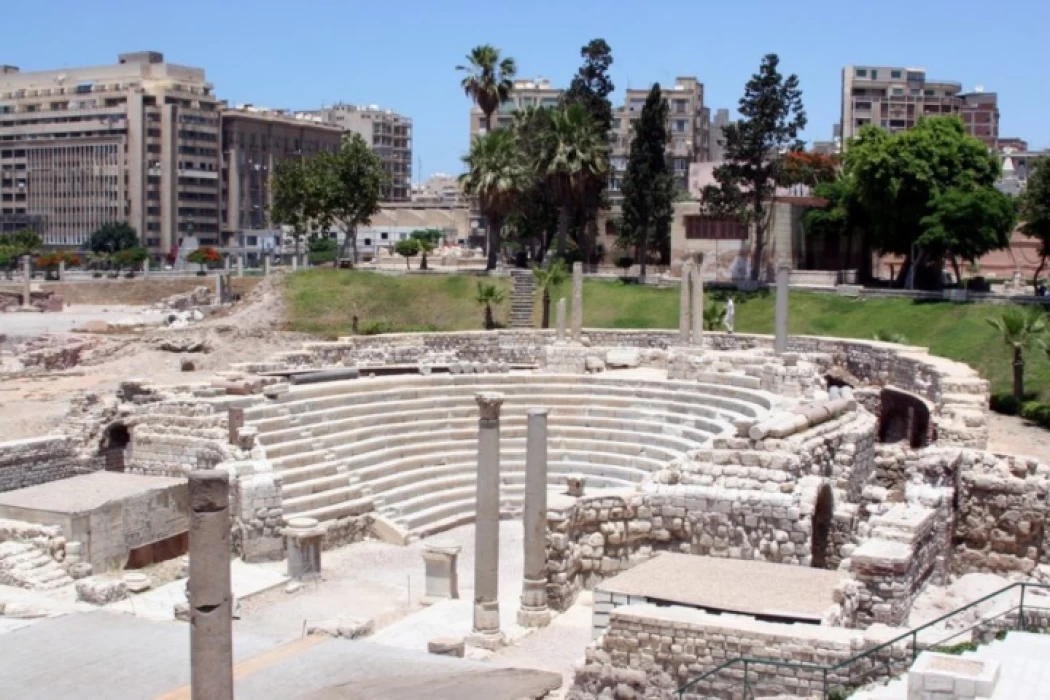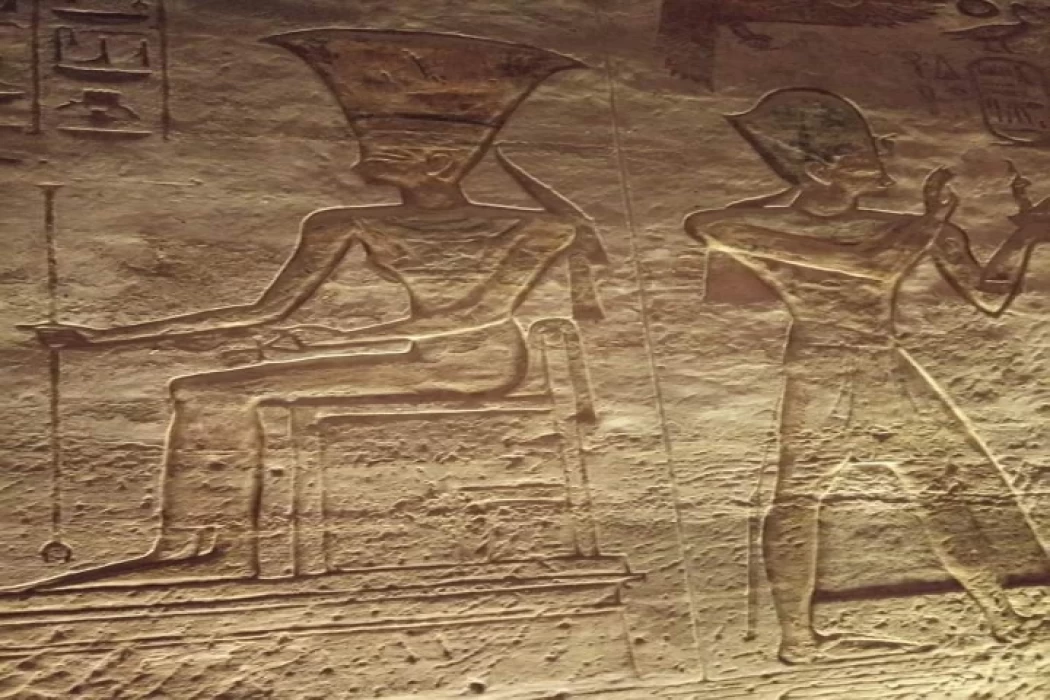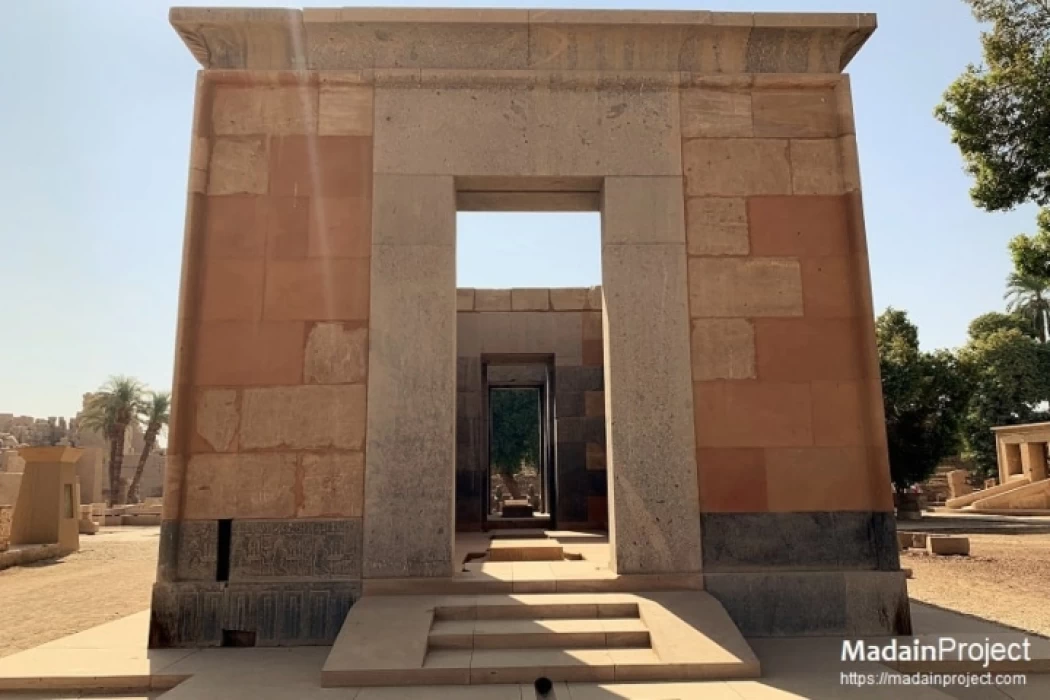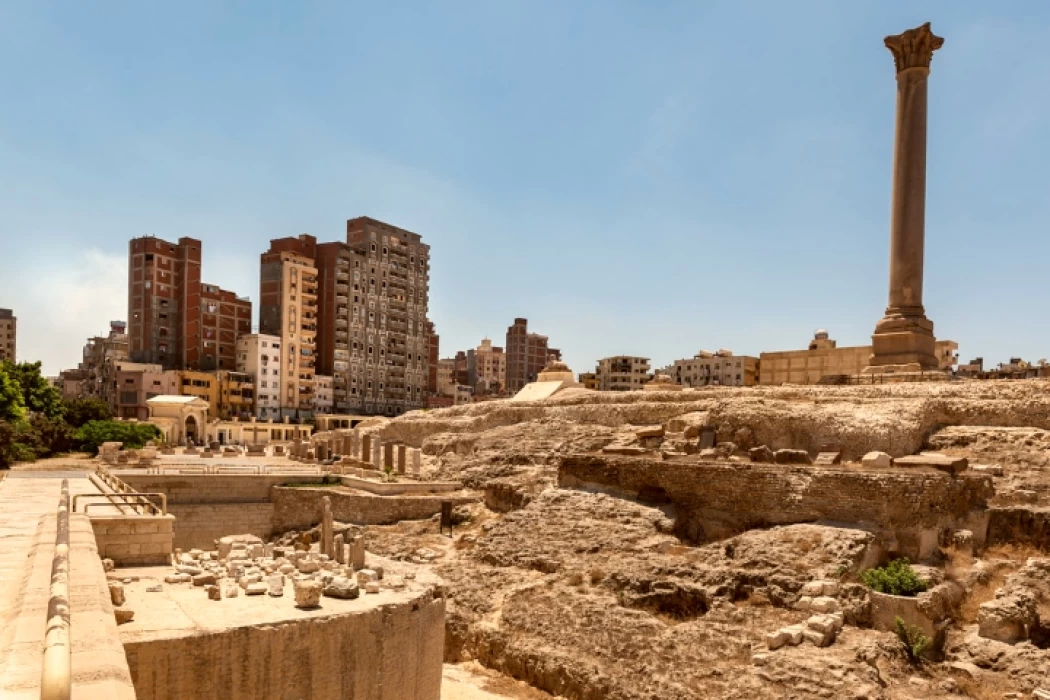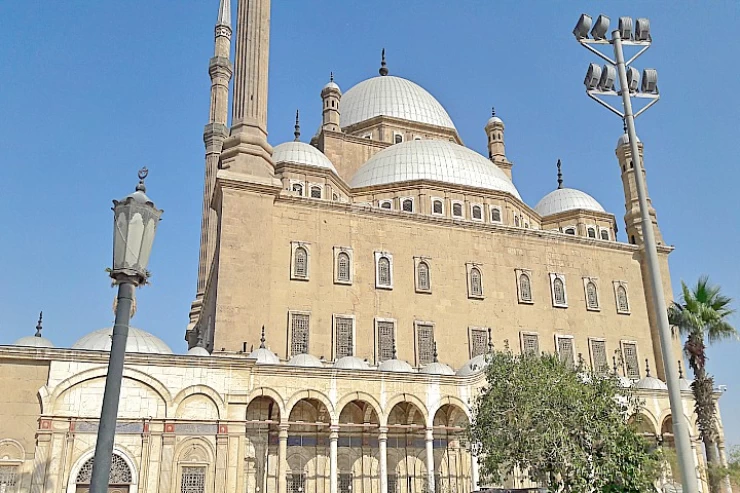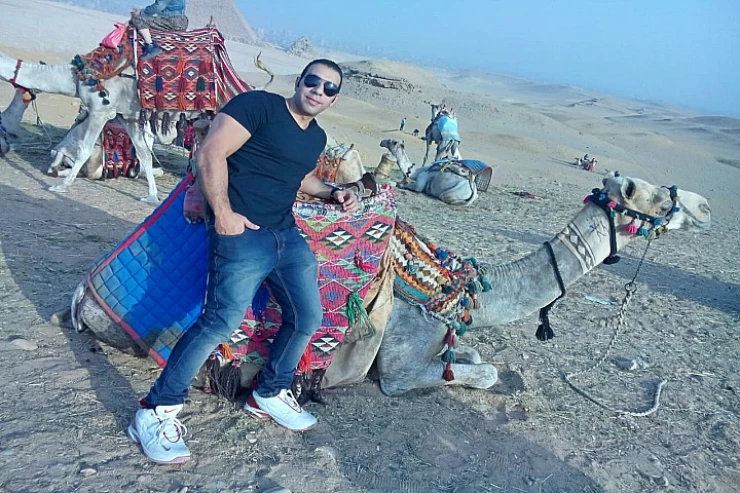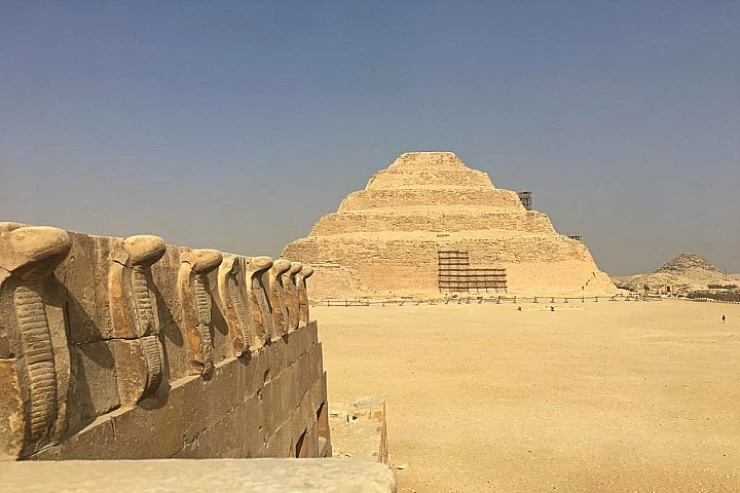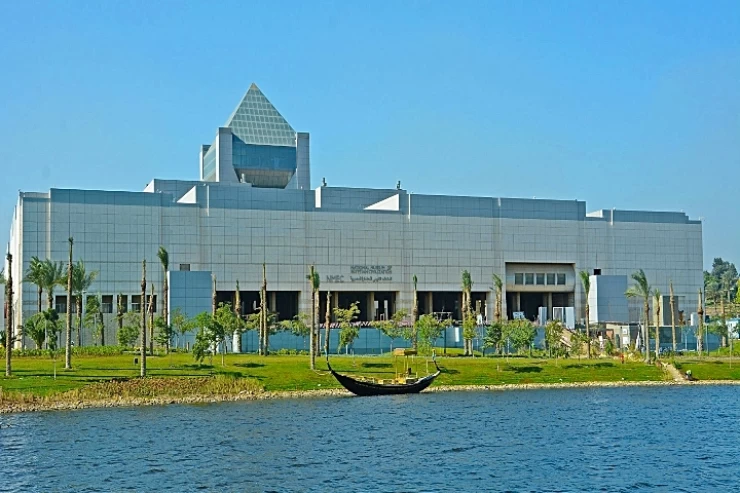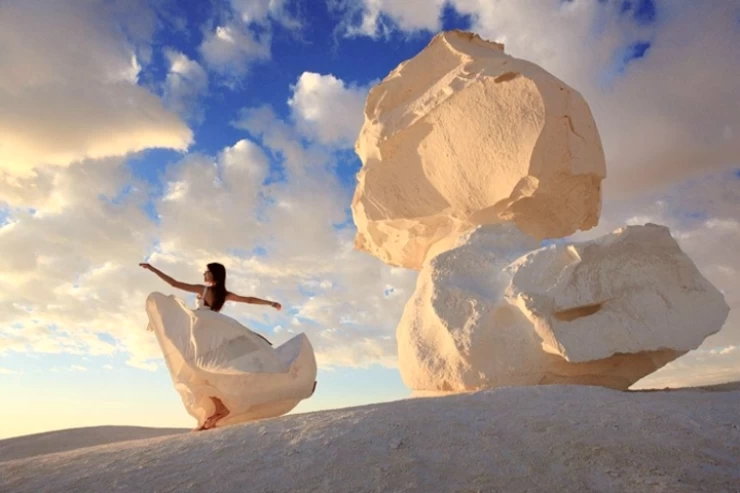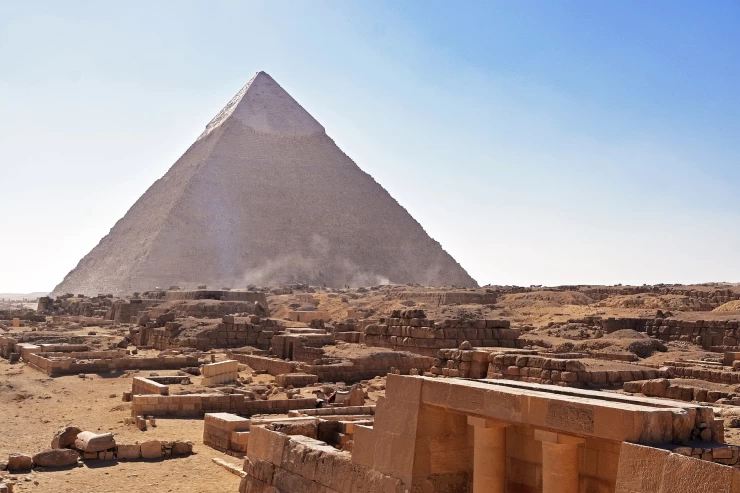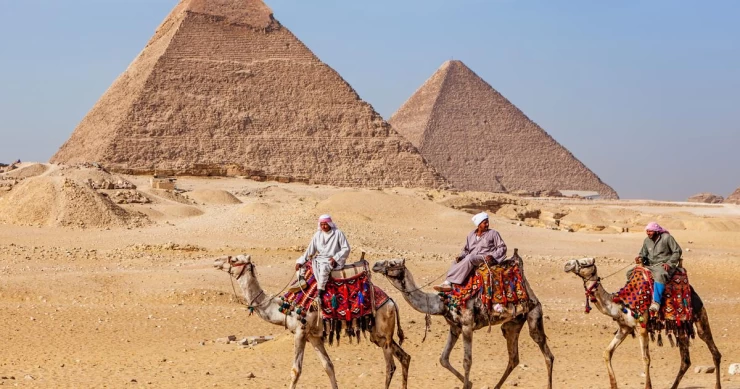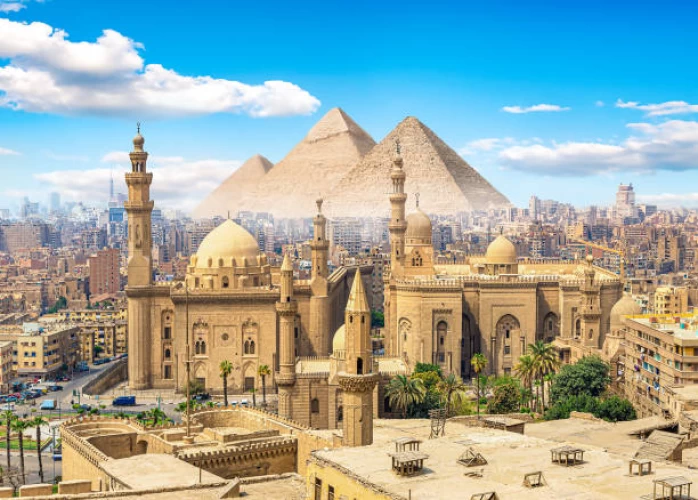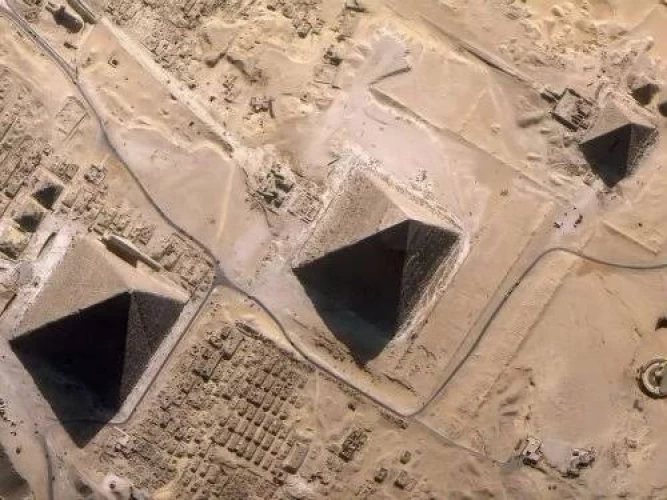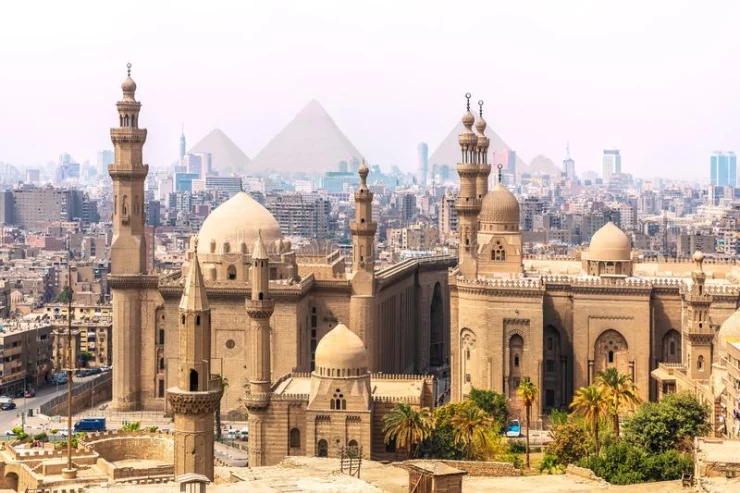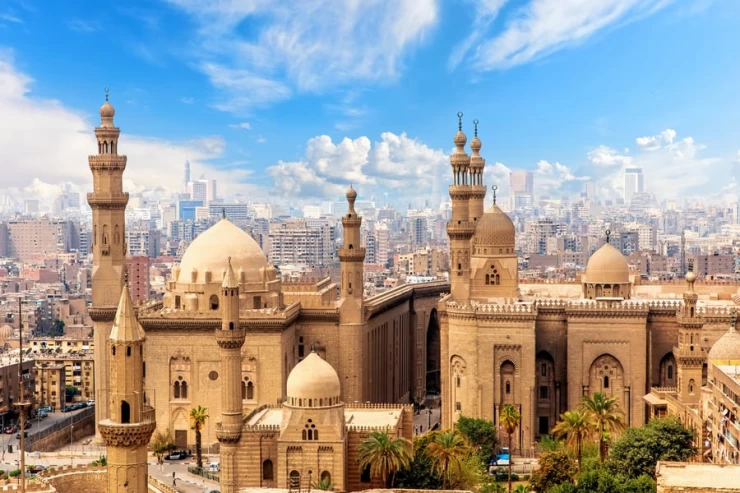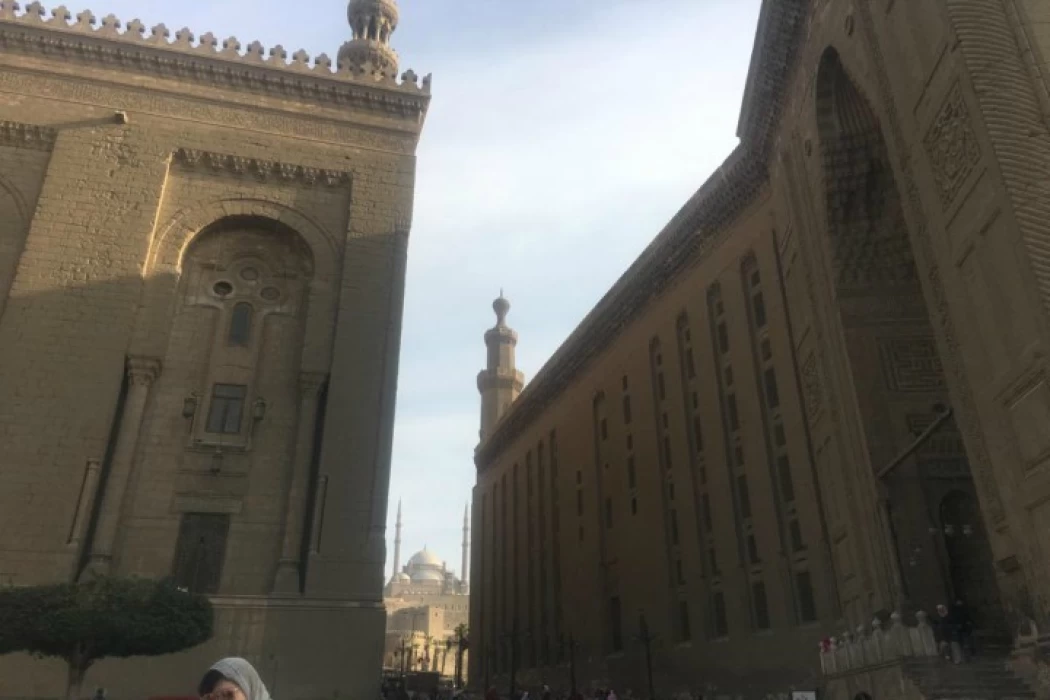
El Sultan Hassan
The Sultan Nasser Hassan mosque and his madrasa, Sultan Hassan madrasa or Sultan Hassan mosque is one of the famous archaeological mosques in Cairo. It is described as the dura of Islamic architecture in the East, and is considered the most harmonious and harmonious monument of Islamic Cairo, and represents the maturity of Mamluk architecture. It was established by Sultan Al-Nasser Hassan bin Al-Nasser Muhammad Bin Qalawun during the period from 757 Ah/1356 to 764 Ah/1363 ad during the era of the maritime Mamluk rule of Egypt. The building consists of a mosque and a school for the four schools (Shafi'i, Hanafi, Maliki and Hanbali), and it also taught the sciences of interpreting the Koran, Hadith, the seven readings, in addition to two offices for memorizing the Koran orphans and teaching them calligraphy.
The site of the mosque was an ancient market called the "horse market" and had a palace ordered to be built by Nasser Muhammad Bin Qalawun for the residence of Prince Yalbugha Al-yahyawi, then Sultan Hassan demolished this palace and built this school in its place. The mosque is currently located in Salah al-Din square (Rumaila Square) in the Khalifa District of the southern region of Cairo, and next to it are several archaeological mosques represented by the Rifai mosque, mahmudiya mosque, Qani Bay Al-Rumah mosque, Gohar Lala mosque, in addition to the Muhammad Ali mosque, Nasser Qalawun mosque in Salah al-Din Castle, and Mustafa Kamel Museum
Sultan King Al-Nasser Hassan bin Al-Nasser Muhammad Bin Qalawun was born in 735 Ah/1334 ad, and was first named qamari, and when the Crown Prince of Egypt chose the name Hassan, he was known by him. The crown prince of Egypt ascended the throne in 748 Ah/1347 ad, at the age of thirteen, and for his young age he was succeeded in managing the affairs of the state by Prince pipga Rus, and Prince mungak was blessed with tangerine and appointed him to the ministry and the round table. In the year 751 Ah/1350 ad, the judges proved that he had reached the age of majority, so he took over the rule and arrested the Princes pipga Rus and Manjak, who had the matters of governance in their hands, which called on the Princes to conspire against him and remove him from the king in 752 Ah/1351 ad, and arrested and appointed his brother King Saleh Saleh in his place. In the year 755 Ah/1354 AD, King Nasser Hassan was returned to the king of Egypt, and during that period the rivalry between the Turkish Princes increased, so the sultan left the reins of the Sultanate to Prince Shaykhun al-Omari, and after his death, Prince sargtemesh al-Nasiri seized the affairs of the state and despoiled and greedy in the Sultanate, Sultan Hassan agreed with a group of princes to get rid of him, they arrested him and defeated his he bought a large number of Mamluks, which raised the Sultan's fears, so he followed a new policy in which he relied on the children of the people, so the strife between the sultan and Prince yalbugha intensified, so the Sultan tried to kill him, but he did not succeed, so he attacked him The Sultan fled, then he and those with him were arrested in Matariya in 762 Ah / 1361 ad on his way to the Levant, and this was the last testament of him, and it was said that he was strangled and thrown into the sea and no grave is known for him
The mystery surrounded the artist who constructed this construction, and the name of the engineer remained unknown, not mentioned by any of the historians, but Herts Pasha concluded from the style of his architecture that he was a foreigner and most likely a Byzantine who received the origins of the Islamic style in one of the Seljuk countries. As for the shade of architecture, its archaeological name was discovered by Hassan Abdel Wahab in 1944 on a text written in a plaster style in the Hanafi school, the text of which:
"In the name of Allah, the Most Merciful, the Most Merciful, the pious are in gardens and eyes, they have entered them in peace and security, and we have removed from their chests the coverings of our brothers on opposite secrets in which no monument touches them and what they are from us with exits . O Allah, O Eternal, inexhaustible, o one of innumerable blessings, I will perpetuate the greatness, empowerment, victory and conquest shown by the survival of those with whom I supported Islam and Muslims and revived...... Hasan is the son of Maulana Sultan Al...... He is the one who has written and written for his descendants. His architecture was praised by Muhammad ibn baylik Al-muhseni"
Prince Muhammad Bin beylik Al-muhseni is one of the princes of thousands and the children of the people, he stood by Sultan Hassan in his ordeal with yalbugha, and his family grew up in the era of Mansur Qalawun, and its members fluctuated in state functions.
Sultan Hassan was succeeded by a venerable architecture that immortalized his name, which was represented in his mosque and school, which historians and archaeologists consider the most beautiful mosques in Cairo and all of Egypt, the best buildings of the Mamluk era and the pride of Islamic architecture in the East as a whole. The location of the mosque was known in the old days as the horse market, and it had a palace ordered by King Nasser Muhammad Bin Qalawun in 738 Ah / 1337 ad for the residence of Prince yalbugha Al-yahyawi, and this palace remained until the Sultan started the architecture of the mosque and the school in 757 Ah / 1356 ad, and work continued on it for the duration of his life, and allocated a huge budget and Sultan Hassan was killed and the school was complete except for some complementary works, some of which were completed by tawashi Bashir al-Jamdar, and some were left intact. He completed the dome of Al-fusiqiya in 766 Ah / 1364 ad, which is a wooden dome erected on eight marble columns, with the circles of which he wrote the verse of the chair and the date of completion of it, and he also completed the construction of the large dome of wood and covered it with lead plates to be the fourth large dome in Egypt after the dome of al-Imam Al-Shafi'i, the dome of Al-Zahir Mosque, and the dome of Nasser Qalawun mosque. The school was opened in the life of Sultan Hassan before its completion, and it was prayed on Friday and blessed by builders and engineers, and classes were held there, and a Waqf was written for it in 760 Ah/1359 ad, and staff and readers were appointed, brushes and chandeliers and beautiful complaints were hung on it, and an imam was appointed for it.
Sultan Hassan decided for the schools of the four madhhabs teachers and observers and appointed salaries for them, and decided for each madhhab a sheikh and a hundred students, from each squad twenty-five applicants and three instructors, and appointed a teacher to interpret the Quran, and appointed with him thirty students, and appointed a teacher of the Hadith, and a reader to read the Hadith with them thirty students, and then appointed he attached two offices to the school to teach the orphans the Qur'an and calligraphy, and decided on clothing and food for them, so if the orphan completed memorization, he would be given fifty dirhams, and his disciplinarian would be given fifty dirhams as a reward for him. The Sultan appointed three doctors, one internal and one for the eyes, each of whom attends the mosque every day to treat those who need treatment from the staff and students, and the third is a surgeon.
The Mamluks took the building as a fortress for them, because it was located in front of the mountain castle, and whenever there was a fitna between them, they would climb to the top of the building and hit the castle, and when these incidents were repeated, Sultan Al-Zahir barquq ordered in 793 Ah/1391 ad to demolish the ladder leading to the roof of the school and block behind the large copper door, and open one of the windows of the school to get inside. In the year 825 Ah/1422 ad, the ears were pronounced in the two lighthouses, the staircase and the carpet were rebuilt, and the door was replaced, which was taken by the supporter Sheikh. When the Princes returned to attack the castle from the school, Sultan Abu said jaqmaq ordered the demolition of the stairs leading to the lighthouses in 842 Ah/1438 ad. In the year 858 Ah/1454 ad, Sultan Abu Al-Nasr Inal entrusted the engineers to inspect the tribal lighthouse, so they found out its safety, but it was found that the dome's bullets had gaps, and its crescent had a warp from its frequent injuries during the wars, so it was lifted and the dome remained without it. In the year 902 Ah/1497 ad, the castle was besieged and the Mamluks exchanged blows to and from the school, and looted the school's rugs, shells and marble. In the year 903 Ah/1497 ad, Prince tumanbai Al-dawadar II renovated the walls of the school and repaired what was damaged, and the sermon was held in it after it was disabled for about ten months. In 906 Ah/1500 ad, al-Ashraf Jan Balat demolished a small part behind the dome mihrab with difficulty and then stopped the demolition. When the crown prince of Egypt, the Just King, Tuman Bey, ordered the restoration of all the demolished walls during the siege of the fortress. Then the big door was blocked again for 51 years since 1149 Ah/1736 ad until 1200 Ah/1785 ad, where Selim Agha repaired the mosque and opened its door, removed the shops from below, and built a new staircase and terrace for it.
The design of the school was developed in an orthogonal way, which includes four bowls with an open saucer in the middle. It was planned to build four lighthouses in the project, three were completed, two of which covered the Dome on the eastern side, and the third was on the right shoulder of the public door, and the third fell in 762 Ah/1361 ad, so Sultan Hassan canceled the construction of the fourth lighthouse, which was planned for the left shoulder, and was satisfied with the two lighthouses
The building was designed in a polygonal shape, with an area of 7906 square meters, where the maximum length is 150 meters, and the maximum width is 68 meters, and it has four eastern, western, tribal and sea views, on the eastern side the dome and two lighthouses, the oldest of which is tribal, and its height from the mosque's nave is 81.60 meters, and a sea lighthouse, which fell in 1070 Ah/1659 ad, and was renovated during the reign of Ibrahim Pasha in 1082 Ah. The sills of the windows of the dome were decorated with strange stalactites and knots, they were inlaid with ribbons of Kashani, and their corners were decorated with columns of stone with Kufic inscriptions. As for the tribal side of the building, it contains the Hanabala and hanafiya schools, and the western side has a toilet under it and in front of it is a water tank that used to deliver water to the schools and to the mosque. While the height of the sea side at the door is 37.70 meters, which is the public side, and on its western side is the public door, which is decorated on both sides with various decorations extending upwards, which was not completed. This door had two wooden shutters covered with the same copper doors, which were transferred by Sultan Al-Mu'ayyad Sheikh to his mosque in sukkariya in 819 Ah/1416 ad, and this door leads to a square-shaped entrance consisting of three iwans with a Qibla dressed in red stone in the middle, and the entrance chest is decorated with colored marble dressed in white marble, and from this entrance it reaches a staircase with five steps lead to a knotted vestibule bent to the left, and ends in a large bowl furnished with colored marble with an area of 34.60 meters * 32 meters, centered on a courtyard topped by a dome mounted on eight columns, and around the bowl are four Iwan, the largest of which is Iwan The mihrab is flanked by a marble pulpit with a hollowed-out Copper Door, and the mihrab is surrounded by two doors leading to the dome.
The dome is square, the length of each of its ribs is 21 meters, and its height to its peak is 48 Meters, and it has a marble mihrab with delicate ornaments, and a cabinet is about eight meters high, and in the middle of the dome is a marble composition written on it that it was created in 786 Ah/1384 ad by drawing the soil of Sultan said martyr King Nasser Hassan and his descendants, but the Sultan was not buried in it as he was killed and no grave is known for him, and his sons Shahab Ahmed, who died in 788 Ah/1386 ad, was buried in it, and his brother Ishmael, and with this dome, he deposited the Qur'an chair consisting of tooth, ebony and wood fillings that were hammered with a precise awamah. The courtyard is surrounded by four madrasas of the four madhhabs, the largest of which is the Hanafi madrasa, with an area of 898 meters, each of which consists of an Iwan and a bowl with a divider in the middle, and then layers on top of each other supervise the dish and the destinations. the Hanafi madrasa had a divider that was transferred to the AL-taught Mardani mosque by the committee for the preservation of Arab antiquities in 1317 Ah/1899 ad.
The ground floor includes a spacious bathroom with an area of 412 meters, and the floor of that side drops six and a half meters from the floor of the mosque, and it is reached by a very beautiful door, in the center of which is a white marble lamp, and along the walls of this place are various facilities and benefits, and also the mosque's annexes are located in the western tribal corner.
Restoration
Restoration of the mosque in 1915
The committee for the preservation of Arab Antiquities, under the supervision of engineer Herts Pasha, made a great effort to repair the architecture of the mosque and school buildings, completed the construction of the two lighthouses and repaired the walls, marble, carpentry and floor, which restored the mosque to its splendor, and these works were completed in mid-1915 at a cost of 40 thousand pounds at that time. In 2012, the Egyptian Ministry of Antiquities began actual procedures for the maintenance of the mosque, as part of its plan to restore the mosque, which was suffering some cracks. The development plan included providing the mosque with an electronic portal, carrying out careful restoration of some of its walls, including the qibla wall and the reader's chair, maintaining the mausoleum dome and the sacristy of the nave, reviewing the electrical network wires inside the mosque to make them invisible to visitors, changing the carpets of the mosque, diverting the water line connected to the main network and keeping it away from the archaeological area, installing surveillance cameras at a cost of up to 78 thousand pounds, as part of a plan to secure the mosque and the archaeological area around the clock through a central control room, and a Heritage Library was prepared in the mosque, including historical books dealing with Egypt in the Islamic era, plans for preparing cultural and religious activities, organizing and holding lectures Cultural, religious, educational and scientific seminars related to the youth of the mosque. The maintenance project also included the allocation of a service area to serve Egyptian and foreign visitors to the area, beautification and afforestation of the archaeological area surrounding the mosque and its rehabilitation in an aesthetic manner befitting the majesty of Islamic monuments in the region.
On May 28, 2021, part of the modern wooden flap of the AL-Fawwara Dome at Sultan Hassan mosque, which was created as part of the restoration work carried out by the committee for the preservation of ancient Arab antiquities at the mosque in 1902, fell.
Latest Articles
Admin
Neper God Of Grain
Neper was the deity of grains, particularly cereals that were important in Ancient Egypt, such as wheat and barley. It was stated that he foretold when the crops would grow, be harvested, and disappear.
Admin
Djoser
Djoser was an ancient Egyptian pharaoh of the 3rd Dynasty during the Old Kingdom and was the founder of that epoch. He is also known by his Hellenized names Tosorthros (from Manetho) and Sesorthos (from Eusebius). He was the son of King Khasekhemwy and Queen Nimaathap, but whether he was also the direct successor to their throne is unclear. Most Ramesside king lists identify a king named Nebka as preceding him, but there are difficulties in connecting that name with contemporary Horus names, so some Egyptologists question the received throne sequence. Djoser is known for his step pyramid, which is the earliest colossal stone building in ancient Egypt
Admin
Kom Al Dikka Alexandria
Kom El Deka, also known as Kom el-Dikka, is a neighborhood and archaeological site in Alexandria, Egypt. Early Kom El-Dikka was a well-off residential area, and later it was a major civic center in Alexandria, with a bath complex (thermae), auditoria (lecture halls), and a theatre.
Admin
The God Anuket
Anuket, in Egyptian religion, the patron deity of the Nile River. Anuket is normally depicted as a beautiful woman wearing a crown of reeds and ostrich feathers and accompanied by a gazelle.
Admin
The Red Chapel of Hatshepsut
The Red Chapel of Hatshepsut or the Chapelle rouge was a religious shrine in Ancient Egypt. The chapel was originally constructed as a barque shrine during the reign of Hatshepsut. She was the fifth pharaoh of the Eighteenth Dynasty from approximately 1479 to 1458 BC.
Admin
The Serapeum of Alexandria
The Serapeum of Alexandria in the Ptolemaic Kingdom was an ancient Greek temple built by Ptolemy III Euergetes (reigned 246–222 BC) and dedicated to Serapis, who was made the protector of Alexandria, Egypt. There are also signs of Harpocrates. It has been referred to as the daughter of the Library of Alexandria.
